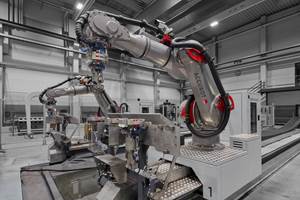NASA selects Blue Origin as second Artemis lunar lander provider
Blue Origin joins SpaceX in design, development, testing and verification of its lander concept to enable recurring astronaut expedients to the moon per the NASA Artemis program.
Artist’s concept of the Blue Moon lander. Photo Credit: Blue Origin
To develop a human landing system for the agency’s Artemis V mission to the moon, (Washington, D.C., U.S.) has selected (Kent, Wash., U.S.). Through Artemis, NASA will explore more of the moon than ever before, uncovering more scientific discoveries, and preparing for future astronaut missions to Mars.
Blue Origin will design, develop, test and verify its Blue Moon lander to meet NASA’s human landing system requirements for recurring astronaut expeditions to the lunar surface, including docking with Gateway, a space station where crew transfer in lunar orbit. In addition to design and development work, the contract includes one uncrewed demonstration mission to the lunar surface before a crewed demo on the Artemis V mission in 2029. The total award value of the firm-fixed price contract is $3.4 billion.
“We are in a golden age of human spaceflight, which is made possible by NASA’s commercial and international partnerships,” Bill Nelson, NASA administrator, says. “Together, we are making an investment in the infrastructure that will pave the way to land the first astronauts on Mars.”
By supporting industry’s development of innovative human landing system concepts and designs, NASA hopes to increase access to space for the benefit of all.
For the Artemis V mission, NASA’s space launch system (SLS) rocket will launch four astronauts to lunar orbit aboard the Orion spacecraft (which uses composite materials). Once Orion docks with Gateway, two astronauts will transfer to Blue Origin’s human landing system for about a week-long trip to the moon’s South Pole region where they will conduct science and exploration activities. Artemis V is at the intersection of demonstrating NASA’s initial lunar exploration capabilities and establishing the foundational systems to support recurring complex missions in lunar orbit and on the surface as part of the agency’s moon to Mars exploration approach.
Adding another human landing system partner to NASA’s Artemis program will reportedly increase competition, reduce costs to taxpayers, support a regular cadence of lunar landings, further invest in the lunar economy and help NASA achieve its goals on and around the moon in preparation for future astronaut missions to Mars.
The agency previously contracted SpaceX (Hawthorne, Calif., U.S.) to demonstrate an initial human landing system for the Artemis III mission. Under that contract, the agency also directed SpaceX to evolve its design to meet the agency’s requirements for sustainable exploration and to demonstrate the lander on Artemis IV. As a result of the contract with Blue Origin to demonstrate on Artemis V a lander that meets these same sustainable lander requirements, including capabilities for increased crew size, longer mission duration and delivery of more mass to the moon, multiple providers will be available to compete for future opportunities to fulfill NASA’s lunar surface access needs for Artemis missions.
By supporting industry’s development of innovative human landing system concepts and designs, NASA hopes to increase access to space for the benefit of all.
“Having two distinct lunar lander designs, with different approaches to how they meet NASA's mission needs, provides more robustness and ensures a regular cadence of moon landings,” says Lisa Watson-Morgan, manager, Human Landing System Program at NASA’s Marshall Space Flight Center in Huntsville, Alabama. “This competitive approach drives innovation, brings down costs and invests in commercial capabilities to grow the business opportunities that can serve other customers and foster a lunar economy.”
NASA issued the solicitation, known as Appendix P, of its second Next Space Technologies for Exploration Partnerships Broad Agency Announcement (Next-STEP2 BAA), in September 2022 as part of the ongoing development of advanced space exploration technologies, capabilities and concepts.
Related Content
NASA launches composite solar sail into space
Sunlight-based propulsion system, supported by carbon fiber-reinforced booms, will undergo weeks-long testing to demonstrate and verify its capabilities.
Read MoreRocket Lab begins installation of large AFP machine for rocket production
The 99-ton AFP machine, custom-designed and built by Electroimpact, is claimed to be the largest of its kind, expecting to save around 150,000 manufacturing hours in the Neutron rocket’s production process.
Read MorePost Cure: Parallel winding technique demonstrates CFRP anisogrid design optimization
Over the years, CIRA has demonstrated its patented CFRP parallel winding technique in a variety of ways for space applications. The lattice structure for the Vega-C launcher stage is a prime example.
Read MoreAutomated robotic NDT enhances capabilities for composites
Kineco Kaman Composites India uses a bespoke Fill Accubot ultrasonic testing system to boost inspection efficiency and productivity.
Read MoreRead Next
Scaling up, optimizing the flax fiber composite camper
Greenlander’s Sherpa RV cab, which is largely constructed from flax fiber/bio-epoxy sandwich panels, nears commercial production readiness and next-generation scale-up.
Read MoreCeramic matrix composites: Faster, cheaper, higher temperature
New players proliferate, increasing CMC materials and manufacturing capacity, novel processes and automation to meet demand for higher part volumes and performance.
Read MoreUltrasonic welding for in-space manufacturing of CFRTP
Agile Ultrasonics and NASA trial robotic-compatible carbon fiber-reinforced thermoplastic ultrasonic welding technology for space structures.
Read More












